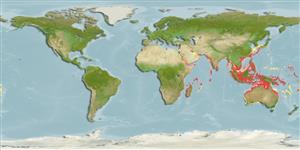Common names from other countries
Environment: milieu / climate zone / depth range / distribution range
Ecología
marino; salobre asociado a arrecife; rango de profundidad 15 - 60 m (Ref. 74961), usually 20 - ? m (Ref. 9710). Tropical; 40°N - 40°S
Indo-Pacific: Persian Gulf and East Africa to New Guinea, south to Western Australia.
Tamaño / Peso / Age
Maturity: Lm ? range ? - ? cm
Max length : 30.0 cm SL macho / no sexado; (Ref. 30573)
Espinas dorsales (total) : 13; Radios blandos dorsales (total) : 10 - 12; Espinas anales: 3; Radios blandos anales: 7 - 8. This species is distinguished by having no spots on the median fins and generally, its shorter dorsal spines (Ref. 74961).
Benthic (Ref. 68964). Found on muddy substrates, from well-protected shallow estuaries to quiet, deep offshore reefs (Ref. 9710, 48635). Also found in bays and coastal waters, solitary (Ref 90102).
Life cycle and mating behavior
Maturities | Reproducción | Spawnings | Egg(s) | Fecundities | Larva
Eschmeyer, W.N., 1986. Scorpaenidae. p. 463-478. In M.M. Smith and P.C. Heemstra (eds.) Smiths' sea fishes. Springer-Verlag, Berlin. (Ref. 4313)
IUCN Red List Status (Ref. 130435)
CITES (Ref. 128078)
Not Evaluated
Human uses
Pesquerías: escaso valor comercial; Acuario: Acuarios públicos
Herramientas
Special reports
Download XML
Fuentes de Internet
Estimates based on models
Preferred temperature (Ref.
115969): 24.6 - 29.1, mean 28.1 (based on 974 cells).
Phylogenetic diversity index (Ref.
82804): PD
50 = 0.5005 [Uniqueness, from 0.5 = low to 2.0 = high].
Bayesian length-weight: a=0.00851 (0.00431 - 0.01683), b=2.96 (2.79 - 3.13), in cm Total Length, based on LWR estimates for this species & (Sub)family-body (Ref.
93245).
Nivel trófico (Ref.
69278): 4.0 ±0.7 se; based on size and trophs of closest relatives
Resiliencia (Ref.
120179): Bajo, población duplicada en un tiempo mínimo de 4.5-14 años (Preliminary K or Fecundity.).
Fishing Vulnerability (Ref.
59153): Low to moderate vulnerability (27 of 100).
